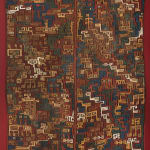Nazca Culture 100 BC-800 AD
Tunic with proliferous Ocucaje Deities, Circa. 300 AD
Camelid fibres
171 x 119 cm
NAZ0045
Copyright of Paul Hughes Fine Arts
Further images
Pulsing with visceral primordial energy and playful bravura, this complete tunic is an electrifying masterwork from the height of early Nazca period. Its extraordinary chromatic range—a pyrotechnic force-field of red,...
Pulsing with visceral primordial energy and playful bravura, this complete tunic is an electrifying masterwork from the height of early Nazca period. Its extraordinary chromatic range—a pyrotechnic force-field of red, blue, lilac, green, yellow and gold—that complements the rich layers of symbolism deem this piece as an extremely rare example of Nazca tunic in a stylised semi-abstracted style.
Part anatomical, part transcendental in its fluidity, the floating body parts and facials represents a vital link to the Nazca visual lexicon that transfers the aggressiveness and powers to the Tunic’s owner. The omnipresent motif of the dual headed snake is the result of the “Contour Rivalry”—a weaving style that emerged in late Chavan and matured in the Nazca period.
A very similar shamanistic force prevailed in the 20th-century art world. Artists turned their study to a diverse artistic heritage across cultures, dissecting and reconstructing the visual and cultural layers through modern practices. The primitivism of Pablo Picasso, the impulsive gestures of Jean-Michel Basquiat’s graffiti, the freedom of Abstract Expressionism and the rhythms of improvised jazz collide with influences drawn from ancient tribal culture and anatomical textbooks. At once deeply personal and universal in its scope, this work lays bare the alchemy of the universal artist’s interior world, slipping seamlessly between abstraction and figuration, the past and the present.
Part anatomical, part transcendental in its fluidity, the floating body parts and facials represents a vital link to the Nazca visual lexicon that transfers the aggressiveness and powers to the Tunic’s owner. The omnipresent motif of the dual headed snake is the result of the “Contour Rivalry”—a weaving style that emerged in late Chavan and matured in the Nazca period.
A very similar shamanistic force prevailed in the 20th-century art world. Artists turned their study to a diverse artistic heritage across cultures, dissecting and reconstructing the visual and cultural layers through modern practices. The primitivism of Pablo Picasso, the impulsive gestures of Jean-Michel Basquiat’s graffiti, the freedom of Abstract Expressionism and the rhythms of improvised jazz collide with influences drawn from ancient tribal culture and anatomical textbooks. At once deeply personal and universal in its scope, this work lays bare the alchemy of the universal artist’s interior world, slipping seamlessly between abstraction and figuration, the past and the present.





